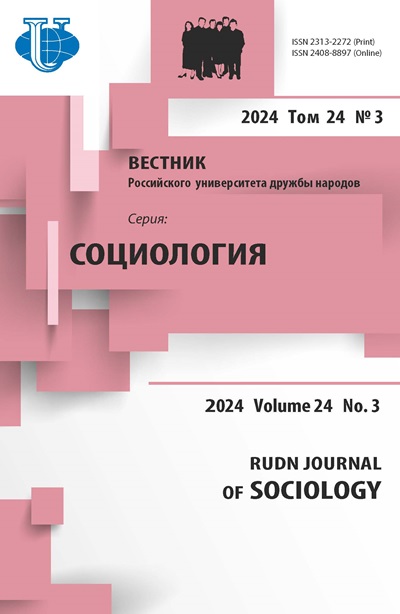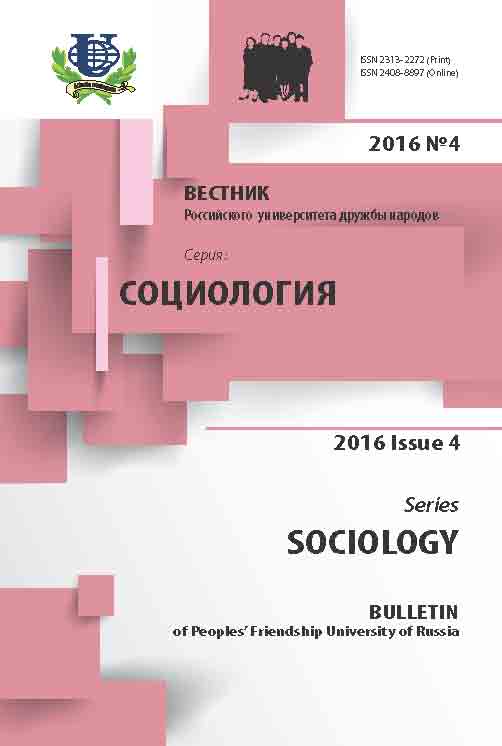Indigenous peoples in the context of cultural continuity
- Authors: Kuropjatnik MS1
-
Affiliations:
- Saint-Petersburg State University
- Issue: Vol 16, No 4 (2016)
- Pages: 769-776
- Section: Contemporary society: the urgent issues and prospects for development
- URL: https://journals.rudn.ru/sociology/article/view/14809
Cite item
Full Text
Abstract
The article defines local and global rather as two complementary perspectives for interpreting the modernity than as two levels of social interaction - micro- and macro-. Following Latour’s new ‘anthropological matrix’ the author shows the way to move from local to global, from representations of cultural forms as authentic (premodern) to their modern interpretations. Cultural continuity is understood as a consequence of the implementation of a multiple ‘partial inclusions’, and as an outcome of the combination of multiple transitions from local to global, from inner context to the outer. One of the most important modes of this continuity constitution is the practice of translation. Regarding indigenous peoples we can speak of two collections of translation practices such as translation of oral-discursive experience of culture into the text, and a reverse translation of cultural narratives created in their being non-literate peoples. Practices of reverse translation consist of the transformation of the ideas initially formed in the outside contexts into the context of the indigenous people’s culture. Such cultural forms as ethnographic self-descriptions are important not only to identify the actual cultural references of the indigenous peoples but also in terms of their involvement in the production of new cultural reality.
About the authors
M S Kuropjatnik
Saint-Petersburg State University
Author for correspondence.
Email: kuropjatnik@bk.ru
Saint-Petersburg, Russia
References
- Burke P. Chto takoie kulturalnaia istoriia? [What is Cultural History?]. M.: Izd. Dom VSE, 2015.
- Bolshakova N.P. Zhizn’, obychai i mify kolskikh saamov v proshlom i nastoiaschem [Life, Customs and Myths of Kola Sami in the Past and Present]. Murmansk: Kn.izd-vo, 2005.
- Clifford G. Ob etnogravicheskoi allegorii [On Ethnographic Allegory]. Sotsiologicheskoie obozrenie. 2014. Vol. 13. No. 3.
- Kristeva J. Izbrannyie trudy: Razrusheniie poetiki [Selected Works: The Destruction of Poet-ics]. М.: ROSSPEN, 2004.
- Latour B. Novogo vremeni ne bylo. Esse po simmetrichnoi antropologii [We have Never been Modern. Essays on Symmetrical Anthropology]. SPb.: Izd-vo Evropeiskogo universiteta, 2006.
- Latour B. Peresborka sotsialnogo: Vvedenie v aktorno-setevuiu teoriiu [Reassembling the So-cial: Introduction to Actor-Network-Theory]. M.: Izd. Dom VSE, 2014.
- Law J. Posle metoda: besporiadok i sotsialnaia nauka [After Method: Mess in Social Science Research]. М.: Izd-vo Instituta Gaidara, 2015.
- Mozolevskaia A.E., Mechkina E.I. Saamskiie uzory [Sami Patterns]. Murmansk: Rekord, 2011.
- Certeau M. Izobreteniie povsednevnosti: 1. Iskusstvo delat’ [The Invention of Everyday Life. 1. The Art of Making]. SPb.: Izd-vo Evropeiskogo universiteta, 2013.
- Habermas J. Politicheskiie raboty [Selected Political Works]. M.: Praksis, 2005.
- Khatami M. Islam v sovremennom mire. Fragment. [Islam in the Modern World. A Fragment]. Dmitriev A.V. Migratsiia: konfliktnoe izmerenie. M.: Al’fa, 2006.














